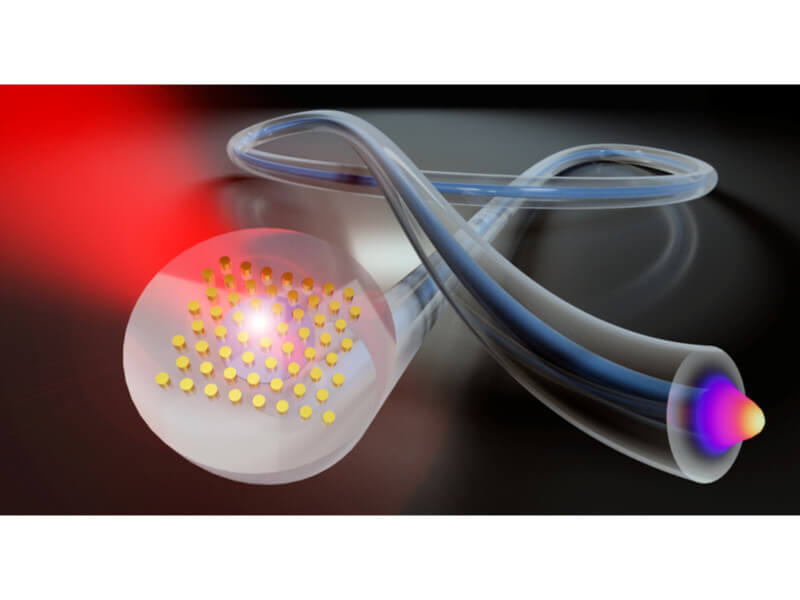- Home
- Research
- Fiber Photonics
- Research results
- Functional nanostructure-enhanced optical fiber probes for light collection
Functional nanostructure-enhanced optical fiber probes for light collection

15.04.2019
Efficient coupling of light into a fiber requires the beam to be aligned almost parallel to the fiber axis within a very small angle range (e.g. 10°). Many applications such as wide-field endoscopy require the collection of light from directions with significantly large angular. This problem can be solved by a plasmonic nanostructure on the end face of an optical fiber. Using a customized nanostructure design diffraction of the incident light by the nanostructure can utilized to achieve incoupling at angles as large as 80°.
By N. Wang // M. A. Schmidt
Optical fibers have reached great success in many areas. However, applications such as wide-field fiber endoscopy or random photon collection in quantum optics which demand to collect light under comparable large angles. This is difficult to achieve with current fiber designs due to small acceptance angles of commonly used step-index fibers (such as the SMF-28).
In order to break through this bottleneck and to improve fiber light-collecting efficiency, we propose to place an array of well-defined resonant nano-elements on fiber end faces. As confirmed by both experiments as well as simulations, plasmonic nanostructures implemented on the end face of regular step-index fibers yield functionalized fibers with a significant improved light-collection performance particular at incident angles > 30°.
As illustrated in Fig.1, when light incident the nanostructured end-face, part of the light is directed into the fiber core via diffraction by the nanostructure array, boosting the light-collection efficiency. Also, the plasmonic resonance of the individual gold nanodots (Fig. 1) further enhance the fiber coupling ability due to the enhanced scattering of the elements. Thereby our concept consists of two ingredients –optical fiber substrate and plasmonic nanostructures – that are uniquely combined via electron beam lithography.
To realize this concept, we employ electron beam lithography to fabricate nanostructures on fiber end-face. In detail, we prepare a flat “substrate” from the fibers by embedding them into a flat glass disk which is mounted into a flat metal can. Using this technology the fibers are planarized and become compatible with planar fabrication technology and can be treated in the same way as typical wafers, representing a significant step forward in the research field of fiber functionalization.
We experimentally demonstrate several orders of magnitude light collection improvement particular for incident angles > 30° in case a regular step index fiber includes a periodic array of metallic nanostructures on one of its end faces. In fact, incoupling via the nanodot-enhanced step index fiber can be detected at angles as large as to 80°, representing a regime that is out-of-reach for fibers with bare end faces. We also develop a toy model to illustrate the impact of the nanostructure on coupling efficiency and carry out full numerical simulations to reveal how to further improve the performance.
The currently used nano-dot array allows achieving large-angle coupling efficiencies of the order of 10-4to 10-5which is sufficient for applications with high photon flux. In the context of medical applications, highly important endoscopic-type applications of the nanostructure enhanced fiber incoupling concept can be anticipated, since bare step index fibers severely suffer from the poor incoupling efficiencies at large incident angles. Extending the nanostructure enhanced coupling concept towards such applications would require increasing coupling efficiency to levels such as 10-1to 10-2, which can be anticipated by using an appropriate nanostructure such as metasurfaces.
Funded by: Free State Thuringia, EFRE, CSC
